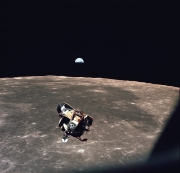
"The Moon is Earth’s closest neighbour and may hold secrets about the formation of our solar system and how life began more than three billion years ago. Humans have only visited the Moon six times and now ESA, along with space agencies around the world, are planning to go back. This return to the Moon envisages a series of human missions starting in the early 2020s that would see astronauts interact from orbit with robots on the lunar surface. Robots will land first, paving the way for human explorers.
This renewed interest in the Moon has been partly motivated by the hunt for lunar resources such as water which exists as ice in permanently shadowed craters at the lunar poles. With so much more to explore, and even more to learn, humanity is looking to the Moon for our next giant leap."
- On the 'Teach with the Moon' by ESA -
Fast Facts
How big is the Moon?
Moon diameter = 3475 km; Earth diameter = 12,742 km
How far is the Moon?
Minimum distance = 363000 km, Maximum distance = 405000 km
How long is a day on the Moon?
A lunar day is 27.3 Earth days long.
How much would you weigh on the Moon?
1⁄6th what you weigh on Earth.
How many people walked on the Moon?
12 astronauts during the Apollo programme (1969 – 1972).
How long does it take to go to the Moon?
Approximately 3 days.
Why does the Moon look bigger at times?
Due to its elliptical orbit.
Is there water on the Moon?
Yes, there is water ice at the poles.
Why do you see so many craters on the Moon?
Craters keep their shape since there is no weather and no tectonic activity.
How long does a radio signal take to travel from the Earth to the Moon?
Approximately 1.28 seconds.
How big does the Earth look from the Moon?
Bigger than what the Moon looks to us from Earth.
What are the dark and bright areas on the Moon?
Lava flows are dark, highlands are bright.
Is there a dark side of the Moon?
No. We talk about the Near and Far sides.
Paxi and Our Moon: Phases and Eclipses (Credit ESA)


